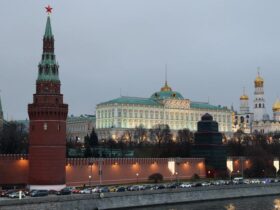The cold in Europe is having an impact on renewable energy production and electricity prices in general. At least that’s what some Scandinavian countries are saying.
Since companies cannot yet store large amounts of electricity, electricity must be used as it is generated. In the past, the European energy market was anchored by electricity produced by fossil-fuel or nuclear plants.
The introduction of more renewable energy into the system brings more instability. As the percentage of renewable energy increases, so does the dependence on the fickle sun and inconsistent wind.
Without the sun solar panels are kept in darkness. Lack of wind prevents wind turbines from rotating. In Europe, this is a phenomenon that usually occurs in winter, a time when more energy is required to stay warm.
Renewable energies could increase instability
The Germans have a word for the period where little or no energy can be produced because wind or sunlight are limited: “Dunkelflaut” or “Dark Doldrums.”
The technical name is “anticyclonic gloom”, which doesn’t sound that dangerous, although experts don’t agree on what exactly needs to happen to get this designation.
Even though it is a slippery term, the phenomenon is serious. With less renewable generation, there is a need to tap other sources of electricity, which could lead to short-term price increases. Sometimes this means importing it from other countries.
At the moment, the dark-gloom effect is highly relevant for prices, “but for the annual average it doesn’t matter much,” said Matthias Meier, an economist at Munich-based IFO. Center for Energy, Climate and Resources,
“In the future, it may have a greater impact, but it is the role of governments and markets to steer the system in directions that minimize the impact of ‘dunkleflow,'” he told DW.
Long-term contracts protect most consumers
Although most electricity consumers in Germany have long-term contracts with price guarantees, others are more price sensitive, particularly industrial producers who pay fluctuating daily rates for their electricity.
Broadly speaking, electricity prices are determined by the type of supply, the cost of maintenance and investment in the grid, taxes and the cost of clean and backup technologies, says Connol Heussaff, a research analyst at the Brussels-based Bruegel think tank.
Heussaff, who examines energy prices and electricity market design, told DW that supply and demand are also factors, but more so in the short term. A clean energy system like the EU would lead to lower average prices in most periods, with so-called spot prices being much higher for periods of time in the free market.
Norway and Sweden face to face
This year, Germany has experienced a brief dark-gloomy period. But one caused a bigger ripple as the country needed more electricity than usual from other locations to meet demand. This led to short-term high prices at home and abroad because electricity went where demand and prices were highest.
On the morning of December 12, the cost of a megawatt-hour of electricity was €107 ($112), but it soon rose to €936, according to data collected by Agora Energiewende, an energy think tank. The next day it fell again and reached a low of less than €115.
Although prices quickly returned to normal, Scandinavia’s reactions were immediate. Norway’s Energy Minister Terje Aasland said he is considering scrapping shared-energy links with Denmark, while others in Norway want to renegotiate existing connections with Germany and the UK, according to British Business. Daily has told. financial Times.
Sweden’s Energy Minister Ebba Busch said she is open to a new underwater cable connection to Germany only if Germany changes its electricity market to protect Swedish consumers and their access to affordable domestic energy.
The call for greater electricity nationalism is in direct conflict with the EU’s goal of an integrated electricity market. If countries ensure low prices domestically before sending electricity abroad, it will damage the system and make it harder to reach climate goals.
How interconnected is the European electricity market?
“Overall, Europe’s electricity market is deeply, physically interconnected and institutionally cohesive, especially considering that it is a collection of many different nations,” Heussaff said. It is the second largest synchronized electricity grid on the planet after China.
Mathias Meier agrees that the European market is well connected, pointing out that “almost every seventh unit of electricity is traded across borders.”
Building cross-border energy infrastructure is a priority for the European Commission. This will reduce dependence on imports. This will ensure better access to energy and help achieve the European Green Deal’s goals of emitting 55% less greenhouse gas emissions by 2030 compared to 1990 levels – making Europe the first climate-neutral continent by 2050.
In 2023, renewable energy will be the EU’s dominant source of electricity. According to Eurostat, the EU’s official statistical agency, they made up 44.7% of the electricity generation mix, an increase of 12% compared to 2022.
Nuclear power accounted for about 23% of electricity generation, while fossil fuels accounted for the other 32%.
Additionally, the EU Commission warns that electricity consumption is expected to increase by approximately 60% by 2030. Of greater concern is that 40% of distribution grids are more than 40 years old, making it difficult to handle increased demand and add more renewable energy. Solar panels on the roof.
To help coordinate needed investments, the EU has come up with the Trans-European Network for Energy. These policies are meant to make it easier to plan and grant permission for cross-border energy infrastructure, including electricity.
How can the European electricity market be reformed?
Almost anything can be improved. And something as complex as the European electricity market can certainly be reformed. However, getting countries to agree, invest and implement remain major hurdles.
For Mathias Meier the biggest challenge to market recovery is “local prices that reflect real demand-supply constraints in combination with competent demand response.”
Value development is also important for Conal Heussaff. He says that till now electricity prices have increased unevenly in Europe. Some regions are fortunate to have renewable resources such as wind, solar or hydropower, which give them an advantage on price. But affordable energy is essential to competitiveness across Europe.
Heussaff generally has three suggestions for reducing prices in Europe: encouraging demand-side flexibility to respond to changing circumstances, better European coordination for cross-border investment, and sharing of energy resources between countries. More physical relationships.
Edited by: Uwe Hessler






Leave a Reply